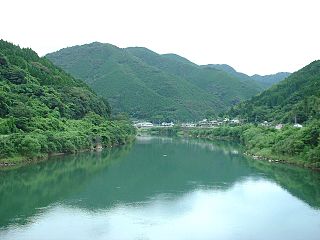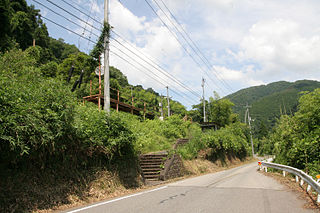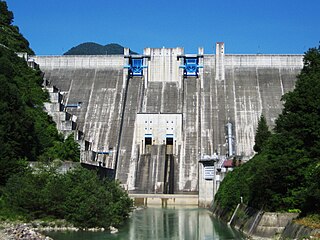
A dam is a barrier that stops or restricts the flow of surface water or underground streams. Reservoirs created by dams not only suppress floods but also provide water for activities such as irrigation, human consumption, industrial use, aquaculture, and navigability. Hydropower is often used in conjunction with dams to generate electricity. A dam can also be used to collect or store water which can be evenly distributed between locations. Dams generally serve the primary purpose of retaining water, while other structures such as floodgates or levees are used to manage or prevent water flow into specific land regions. The earliest known dam is the Jawa Dam in Jordan, dating to 3,000 BC.

A spillway is a structure used to provide the controlled release of water from a dam or levee downstream, typically into the riverbed of the dammed river itself. In the United Kingdom, they may be known as overflow channels. Spillways ensure that water does not damage parts of the structure not designed to convey water.

The Shinano River, known as the Chikuma River in its upper reaches, is the longest and widest river in Japan and the third largest by basin area. It is located in northeastern Honshu, rising in the Japanese Alps and flowing generally northeast through Nagano and Niigata Prefectures before emptying into the Sea of Japan.

The Kuma River is a river in Kumamoto Prefecture, central Western part of Kyūshū, Japan. It is sometimes referred as Kumagawa River. It is the longest river in Kyushu, with the length of 115 km long and has a drainage area of 1,880 km2 (730 sq mi). The tidal flat of the Kuma River estuary is approximately 1000 hectares.

The Yokohama Municipal Subway Blue Line is a rapid transit line serving Yokohama in Kanagawa Prefecture, Japan. It is the longer of the two lines in the Yokohama Municipal Subway system operated by Yokohama City Transportation Bureau, and is the second-longest subway line in Japan at 40.4 kilometers (25.1 mi) in length, surpassed only by the 40.7-kilometer (25.3 mi) long Toei Oedo Line in Tokyo.

Malampuzha Dam is the second largest dam and reservoirs in Kerala, located near Palakkad, in the state of Kerala in South India, built post independence by the then Madras state. Situated in the scenic hills of the Western Ghats in the background it is a combination of a masonry dam with a length of 1,849 metres and an earthen dam with a length of 220 metres making it the longest dam in the state. The dam is 355 feet high and crosses the Malampuzha River, a tributary of Bharathappuzha, Kerala's second longest river. There is a network of two canal systems that serve the dam's reservoir of 42,090 hectares.
Junko Kusayanagi is a Japanese voice actress from Kanagawa, Japan.

Nagatani Station was a railway station on the Sankō Line in Miyoshi, Hiroshima Prefecture, Japan, operated by West Japan Railway Company. Opened in 1969, The station closed on 31 March 2018 with the closure of the entire Sanko Line.

The Samanala Dam is a dam primarily used for hydroelectric power generation in Sri Lanka. Commissioned in 1992, the Samanalawewa Project is the third-largest hydroelectric scheme in the country, producing 405 GWh of energy annually. It was built with financial support from Japan and the United Kingdom. It is notable for a large leak on its right bank. Power production continues as planned despite the leakage, and the water from the leak now provides two thirds of the water issued by the reservoir for agriculture in downstream areas.

The Gōnokawa River is a river that runs through Hiroshima and Shimane prefectures in Japan. It is the largest river in the Chūgoku region. It is also called the Gōgawa River and, in Hiroshima, the Enokawa River.
Water supply and sanitation in Japan is characterized by numerous achievements and some challenges. The country has achieved universal access to water supply and sanitation; has one of the lowest levels of water distribution losses in the world; regularly exceeds its own strict standards for the quality of drinking water and treated waste water; uses an effective national system of performance benchmarking for water and sanitation utilities; makes extensive use of both advanced and appropriate technologies such as the jōkasō on-site sanitation system; and has pioneered the payment for ecosystem services before the term was even coined internationally. Some of the challenges are a decreasing population, declining investment, fiscal constraints, ageing facilities, an ageing workforce, a fragmentation of service provision among thousands of municipal utilities, and the vulnerability of parts of the country to droughts that are expected to become more frequent due to climate change.

The Shin-Takasegawa Pumped Storage Station (新高瀬川発電所) uses the Takase River to operate a pumped storage hydroelectric scheme about 12 kilometres (7.5 mi) west of Ōmachi in Nagano Prefecture, Japan. Part of the system is within Chūbu-Sangaku National Park.

The Ōmachi Dam is a concrete gravity dam on the Takase River just west of Ōmachi in Nagano Prefecture, Japan. Construction of the dam began in 1975 and it was completed in 1985. The primary purpose of the dam is water supply and it also supports a 13 MW hydroelectric power station. It is owned by TEPCO.
Juichi Nagatani was a Japanese long-distance runner. He competed in the marathon at the 1928 Summer Olympics.

20 Seiki Denki Mokuroku is a Japanese light novel written by Hiro Yūki and illustrated by Kazumi Ikeda, with art and backgrounds by Momoka Nagatani. The novel won an honorable mention in the full-length novel category at the 8th Kyoto Animation Awards in 2017, and was the only series to win an award that year. Kyoto Animation published the novel under their KA Esuma Bunko imprint on August 10, 2018 (ISBN 978-4-907064-88-4). On July 27, 2018, KA Esuma Bunko's Twitter account announced that an anime adaptation of the novel would be produced, and would be animated by Kyoto Animation, but the project's status is currently unknown following the Kyoto Animation arson attack which destroyed the main production office.

Granbelm is a 2019 Japanese anime television series created and produced by Nexus. The series was directed by Masaharu Watanabe and written by Jukki Hanada, with original character designs by Shinichirou Otsuka, and music composed by Kenichiro Suehiro. Granbelm aired from July 5 to September 26, 2019 on the Animeism programming block. The series follows a group of 7 magical girls that pilot giant robots called "Armanox", where they fight in a battle royale where the winner obtains the title "Princeps Mage", allowing the user to wield all the magic inside the "Magiaconatus".

Patrick Nagatani was an American photographer and educator perhaps best known for his work relating to the unique history of Japanese Americans including their experience with internment camps.
The Dayak Desa War or Majang Desa War was an armed uprising by the Dayak Desa tribe, and later Indonesian nationalists, in West Kalimantan against the Japanese Empire and the Dutch East Indies during World War II. The war was initially caused by the local population's opposition against the rōmusha system and disappointment with Japanese occupation. In the initial phase of Japanese occupation, several Japanese companies entered the region to gain natural resources in order to support the Japanese war effort in the Pacific. Occupying Japanese forced locals to work for free for these companies, mainly in coal mining and timber production. After that, a Japanese foreman working in a company wanted to marry the daughter of Pang Linggan, a respected Dayak chief in the region, which caused more tension between locals and the Japanese. Dayak tribes in the region initiated mangkuk merah ritual, as a sign to mobilise men from villages and prepare for war. The Japanese were driven out of the Borneo interior in June 1945, but returned on 17 July and continued until 31 August 1945 when Japanese forces there surrendered and left the region, replaced by Allied forces including the Dutch, who would later be opposed again until recognition of Indonesian independence in 1949.

Chie Nagatani, better known by her ring name Lady C, is a Japanese professional wrestler currently working for the Japanese promotion World Wonder Ring Stardom.
















